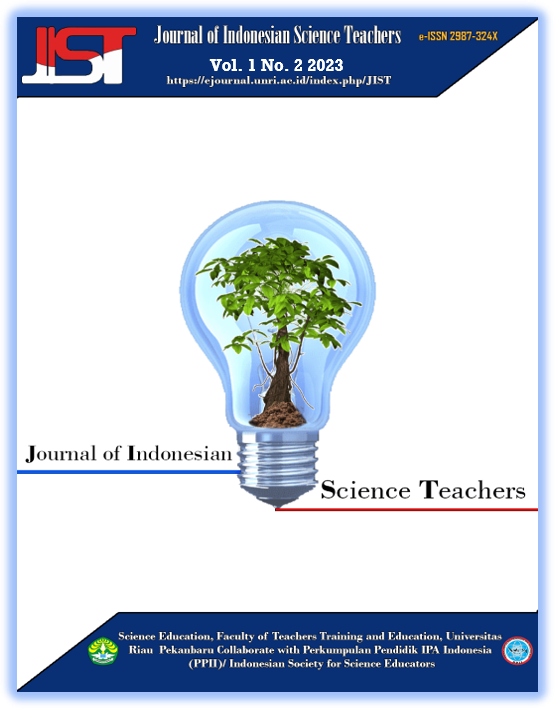Application of Mobile Learning to Increase Interest in Learning Science in Class VII Junior High School Students
Keywords:
mobile learning, learning interests, material classification and its changesAbstract
This research aimed to determine the increase in students' interest in learning science by studying the concept of material classification and its changes, through mobile learning learning media. The research method uses a pretest-posttest control group design with quantitative data types. Data on students' learning interests was collected through distributing learning interest questionnaires before and after learning using mobile learning media. The research instrument was prepared based on ARCS learning interest aspects (attention, relevance, self-confidence, and satisfaction). Data were analyzed descriptively using a Likert scale and inferentially using the Independent Sample T-Test. The results of the research showed that students' interest in learning had increased in the experimental class with a good category of 83% and a very good 17%. Inferentially, a significant increase in interest in learning was obtained. These results provide the conclusion that the application of mobile learning media has a positive impact on increasing student interest in learning better in learning material classification and its changes in class VII Junior High School.
References
Alfisyahrina, F., Djudin, T., & Mursyid, S. (2018). Remediasi miskonepsi siswa pada materi suhu dan kalor menggunakan model PBL di MAN. Jurnal Pendidikan dan Pembelajaran Khatulistiwa, 4(9).
Çukurbaşı, Ç. E., Sabuncu, F. H. & Kışla, T. (2022). Mobile learning in grades K–12: A literature review. Journal of Educational Technology & Online Learning, 5(4), 1000-1029.
Daryanto. (2014). Pendekatan pembelajaran saintifik kurikulum 2013. Penerbit Gava Media.
Hendrawijaya, A. T. (2022). Effects of mediation of learning interest in improving student learning achievement. International Journal of Instruction, 15(1), 857-872. https://doi.org/10.29333/iji.2022.15149a
Hidayatullah, M. S. (2016). Pengembangan media pembelajaran berbasis flipbook maker pada mata pelajaran Elektronika Dasar di SMKN 1 Sampang. Jurnal Pendidikan Teknik Elektro, 5(1), 87.
Hosen, M.S. (2022). The ICT on the education system and it’s future prospects in Bangladesh. AGPE The Royal Gondwana Research Journal of History, Science, Economic, Political and Social Science, 3(2),48.
Jeno, L.M., Dettweiler, U., & Grytnes, J. A. (2020). The effects of a goal-framing and need-supportive app on undergraduates’ intentions, effort, and achievement in mobile science learning. Computers & Education, 159 (2020) 104022.
Kadir, D. K., & Akpinar, E. (2018). The effect of mobile learning applications on students' academic achievement and attitudes toward mobile learning. Malaysian Online Journal of Educational Technology, 6 (2), 48-59.
Keller, J. M. (1987). Development and use of the ARCS model of instructional design. Journal of instructional development, 10(3), 2-10.
Kim, J.H., & Park, H. (2019). Effects of smartphone-based mobile learning in nursing education: A systematic review and meta-analysis. Asian Nursing Research, 13 (2019) 20-29. https://doi.org/10.1016/j.anr.2019.01.005
Klimova, B. (2019). Impact of mobile learning on students’ achievement results. Educ. Sci. 9 (90) 1-8. doi:10.3390/educsci9020090
Laelasari, D., Nulhakim, L., & Nestiadi, A. (2023). Pengembangan media pembelajaran mobile learning berbasis android pada pembelajaran IPA di Kelas VIII SMP/MTs tema makananku kesehatanku. PENDIPA Journal of Science Education, 7(1), 24–32. https://doi.org/10.33369/pendipa.7.1.24-32
Meliana, A., Hidayat, A., & Ilyas. (2016). Pengembangan media pembelajaran mobile learning berbasis android untuk meningkatkan minat belajar siswa di SMA Plus Al-Ghifari. Jurnal Pendidikan dan Pembelajaran Ekonomi Akutansi, 2(2), 91-104. https://jurnal.fkip.unla.ac.id/index.php/jp2ea/article/view/131
Nurhafizah, Melati, H.A., & Rasmawan, R. (2017). Deskripsi pemahaman konsep materi dan perubahannya siswa kelas X SMK SMTI Pontianak. Jurnal Pendidikan : 65-68.
Nurul, A., Ma'aruf, Z., & Rahmad, M. (2021). Pembuatan media pembelajaran berbasis mobile learning pada materi klasifikasi materi dan perubahannya untuk siswa SMP kelas VII. JOM FKIP-UR, 8(2), 1-11.
Pribadi, B.A.,(2017). Media dan teknologi dalam pembelajaran. Kencana.
Rahmad. M. (2018). Pembangunan dan keberkesanan e-kandungan berasaskan PBL terhadap minat dan pencapaian pelajar dalam kursus Elektronik Asas. Disertasi (S3), Fakulti Pendidikan Universiti Kebangsaan Malaysia.
Rizqillah, I. F., Syarbini, A., & Hendrayana, A. (2016). Pengembangan media mobile learning dan minat siswa pada pembelajaran IPA Terpadu. Jurnal Teknologi Pendidikan dan Pembelajaran, 3(2), 145-156. https://jurnal.untirta.ac.id/index.php/JTPPm/article/view/7758
Samsinar, S. (2020). Mobile learning: Inovasi pembelajaran dimasa pandemi covid-19. Al-Gurfah: Journal of Primary Education, 1(1), 41-57
Samudra, G.B., Suastra, I.W., & Ketut , S. K. (2014). Permasalahan-permasalahan yang dihadapi siswa SMA di Kota Singaraja dalam mempelajari Fisika. e-Journal Program Pascasarjana Universitas Pendidikan Ganesha, 4(1).
Sattarov A. R, & Khaitova, N. F. (2019). Mobile learning as new forms and methods of increasing the effectiveness of education. European Journal of Research and Reflection in Educational Sciences, 7(12).
Suendarti, M., & Virgana. (2022). Elevating natural science learning achievement: Cooperative learning and learning interest. Journal of Education and Learning. (EduLearn), 16(1), 114~120. DOI: 10.11591/edulearn.v16i1.20419
Sugiyono. (2019). Metode penelitian pendidikan. Alfabeta.
Supardi U.S., Leonard, Suhendri, H., & Rismurdiyati. (2019). Pengaruh media pembelajaran dan minat belajar terhadap hasil belajar Fisika. Jurnal Formatif, 2(1), 71-81.






